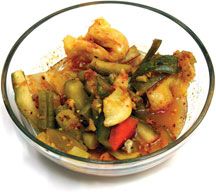 |
|
| Kimchi. Photo courtesy of Tan Wei Ming; Agency: Dreamstime.com. |
As science and technology rapidly alter the way health is perceived by our society, it is crucial that we continuously reflect back to the past, to simpler times, and honor Hippocrates’ widely cited but often ignored adage, “Let food be thy medicine.”
The food industry has certainly taken this concept to heart in recent years. Almost every week, some company somewhere is launching a new “functional food”—a common food item bolstered by the addition of ingredients that have either specific health-promoting or specific disease-preventing attributes that go beyond the basic nutrient profile of the food. We’ve now got orange juice with added plant sterols for heart health, eggs enriched with omega-3 fatty acids, and many other interesting functional food options.
Functional foods are a hot market these days. But as the food industry juggles its new definitions, legalities, and focus group data to optimize the growing interest in this field, keep in mind that there’s really nothing new about using specific foods to prevent or treat health conditions. People around the world have been doing this for centuries. And many of the most valuable traditional functional foods are fermented. I call them “Triple F’s: Functional Fermented Foods.”
Kefir Factor
 |
|
| Traditional method for preparation of kimchi. Photo courtesy of Tan Wei Ming; Agency: Dreamstime.com. |
Fermentation refers to the growth of beneficial microorganisms — more widely known as probiotics — on common foods. Historically speaking, FFFs can be found in nearly every culture and civilization. Examples include kimchi, a form of fermented cabbage from Korea, that is a daily staple in nearly all Korean households. Kimchi production can be traced back nearly 3,000 years. Kefir, a fermented dairy product gaining recent popularity, originally comes from Turkey. The word actually means “to feel good.” Kefir was so prized for its health benefits that the Turks almost went to war with neighboring Russia in order to protect the kefir recipe.
Many modern condiments, including ketchup and mustard, were originally fermented foods, though nowadays, they’ve been nutritionally neutered to the point where they are strictly flavor-enhancers. Miso, tempeh, and natto are all fermented soy foods, which have been staples in Japanese diets for centuries. Sauerkraut, kombucha, pickles, certain vinegars, sourdough breads, beer, and of course, yogurt are all examples of fermented foods that can benefit your health and improve an individual’s digestive system.
Many people today are using probiotic supplements. But I believe certain fermented foods should also be incorporated into the diet. Fermentation gradually changes the characteristics of the food through the action of enzymes, produced by the probiotic bacteria, molds and yeasts. In many types of foods, especially soy, this enzymatic processing enhances the nutritional value, improves digestion, and promotes a healthy inner ecosystem.
“Reforesting” the GI Tract
We should have over 400 species of beneficial organisms living in our gut, keeping balance and maintaining health. For many of our patients (and ourselves), high stress levels, use of antibiotics, and consumption of processed foods have destroyed our inner ecosystem. Probiotic supplements can be expensive and unfortunately, not always effective. Fermented foods which, for the most part have been around for thousands of years, contain minerals, enzymes, probiotics, and other important nutrients necessary to recolonize your inner ecosystem and restore your health. They also help support an environment that makes probiotic supplementation even more effective.
For many people today, the term “diet” means little more than an onerous list of pleasurable foods that need to be given up in order to preserve or restore health. Few people think about those items that we ought to incorporate into our meal selection in order to maintain our health and well being. Traditional fermented foods like miso, natto, kefir, kimchi, and tempeh are among those that can bring both health benefits and culinary pleasure back into our patients’ lives.
The rise in chronic diseases over the last 50–100 years has been attributed to many factors: processed foods, high sugar intake, lack of exercise, and of course the overuse of antibiotics are high on the list. But when we look at the underlying causative factors contributing to the ill state of our society, it is interesting to note that the dialog almost always overlooks the near-complete elimination of living, probiotic and enzyme-rich fermented foods from our diet, especially since the rise of industrialization and the advent of pasteurization.
Whereas every culture around the world seems to incorporate some form of cultured, fermented food into their diet, our allegedly “advanced” American way of life has all but excluded the fermented medicinal foods of our history. Only recently has this category gained some exposure, largely because of the increased interest in probiotic supplements and the mounting evidence that they can be effective in treating many gastrointestinal conditions. In some probiotic studies, the researchers note unexpected improvements in several other disease states previously thought to be unrelated.
FFFs are beneficial to people of all ages, including young children. “They are ideal for pregnant women, ensuring a healthy birth canal for her newborn child who will rely on her to provide healthy bacteria,” says Donna Gates, author of The Body Ecology Diet. She adds that children with autism and ADD often benefit from increased consumption of probiotic fermented foods.
Mainstream food manufacturers have also started to realize the value of FFFs. Dannon™, the yogurt industry giant recently launched DanActive™ and Activia™, which are marketed as “probiotic-rich” yogurts aimed at both children and adults. The pitch is that these products promote better health and strengthen immune system function. Using scientific studies to support their products, more and more companies are expected to jump on the Triple F trend, promoting better digestion and overall wellbeing.
Among the more interesting entries into this field is G.T.’s Raw Kombucha, which is a living fermented beverage loaded with probiotics, enzymes, and amino and organic acids.
Certainly, the food industry’s versions of FFFs offer convenience. But many of these beneficial foods can be made at home at very low cost to the consumer. When made properly, they are often superior to the commercial products. Starter cultures, which supply specific beneficial strains of bacteria necessary to make homemade kefir, yogurt and fermented vegetables are readily available through online retail sites like Donna Gates’ Body Ecology (www.bodyecologydiet.com) and others. Yogurt, kefir and various vegetable preparations are easy to make at home. Others, like natto, miso and tempeh, are much more challenging.
The word “doctor” as many know, means “teacher” in Latin. It is important to learn from the past, and to apply that knowledge to both the present and future. Although new science continues to unfold, and technology enhances our understanding of the human condition, we must not overlook the simple, yet effective tools of our ancestors.
Dr. Rob Streisfeld is both a Doctor of Naturopathic Medicine and a gourmet natural food chef. With a background in anthropology, “Doc Rob” has been studying the impact and benefits of traditional foods and the correlation to digestive health.







